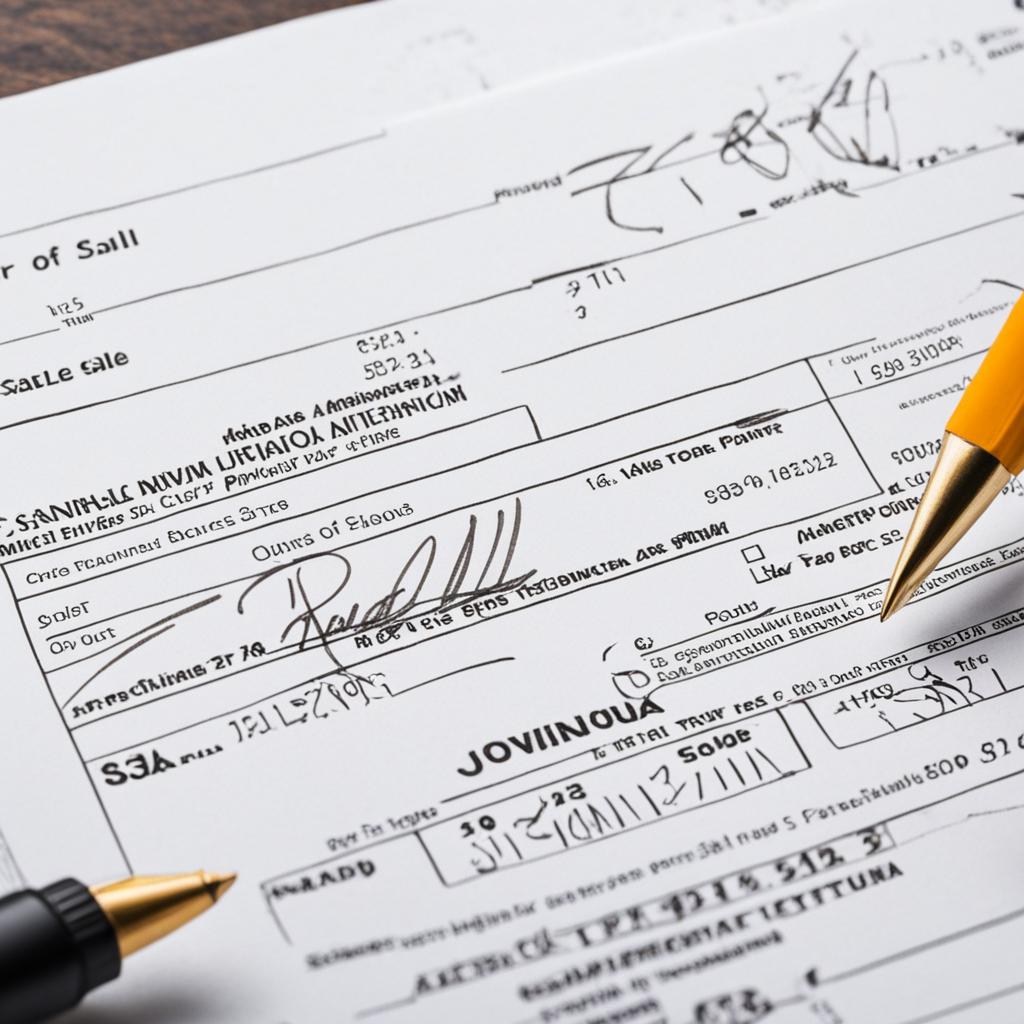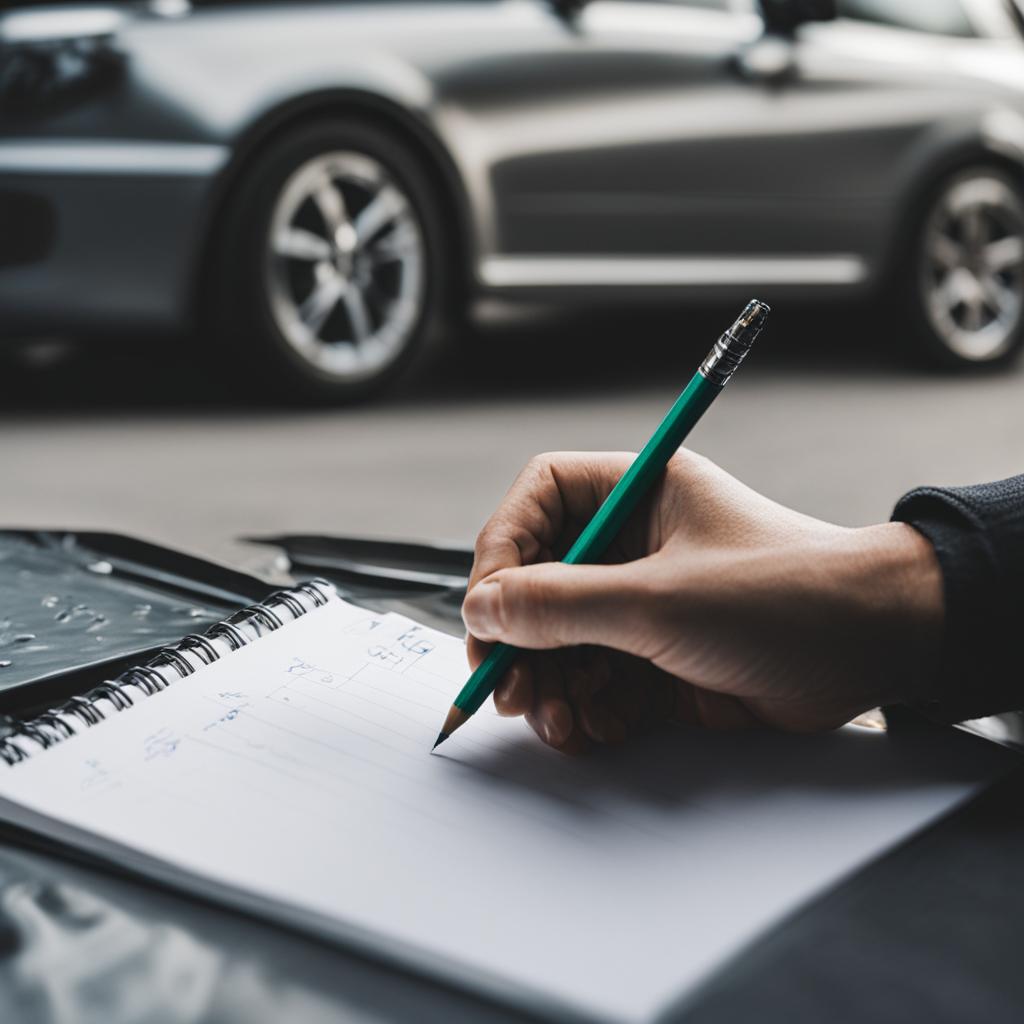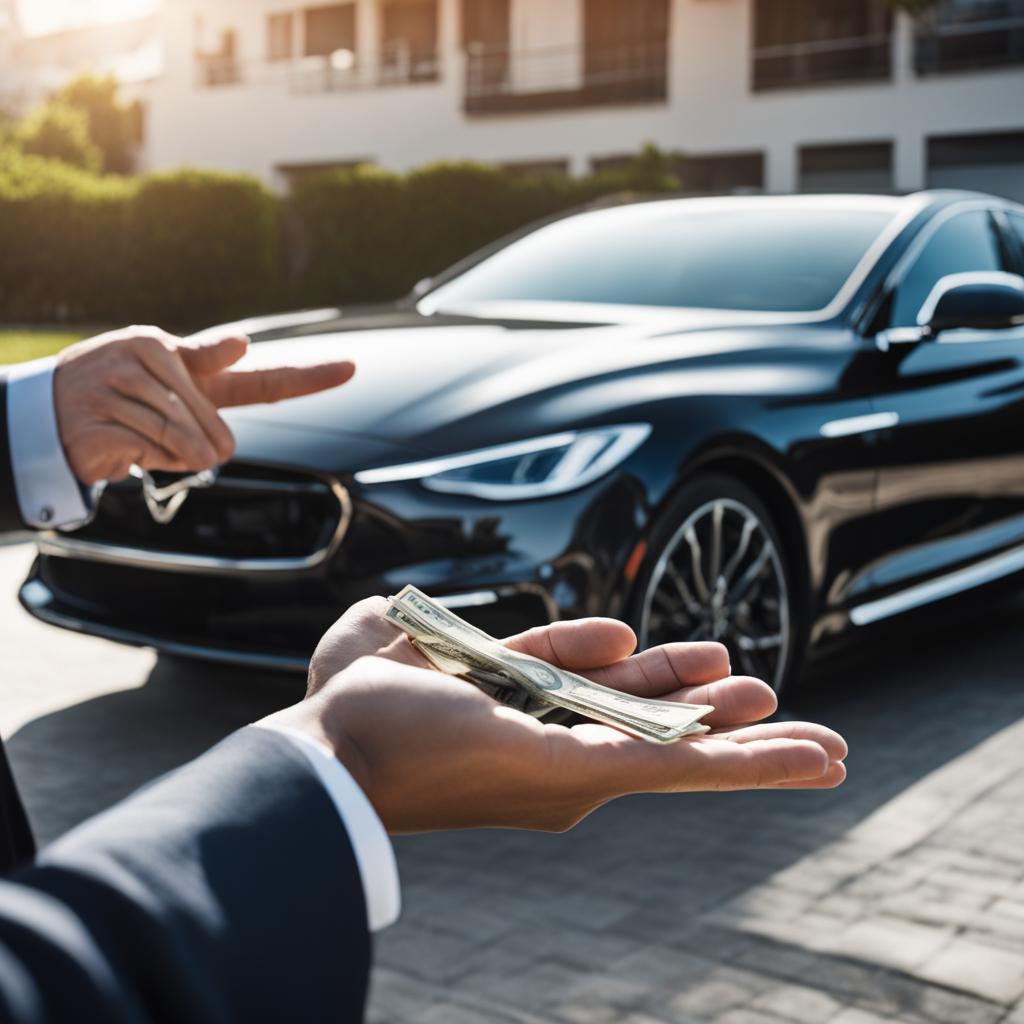Flipping cars can be an exciting and profitable venture for car enthusiasts and aspiring entrepreneurs alike. If you have a passion for cars and some mechanical knowledge, you can turn that into a lucrative side hustle by buying and selling cars for profit. In this comprehensive guide, I will provide you with essential tips and techniques to successfully flip cars and make money in the process.
From understanding the legal requirements to finding the right cars to flip, pricing your flips strategically, and maximizing your profit margins, I will walk you through each step of the car flipping business. Whether you’re a seasoned flipper looking to refine your techniques or a beginner interested in taking your first steps, this guide has got you covered.
Key Takeaways:
- Flipping cars can be a profitable side hustle if you have a passion for cars and some mechanical knowledge.
- Research and understand the legal requirements for flipping cars in your state to avoid fines and legal issues.
- Car auctions, online platforms, local classifieds, and word-of-mouth are great sources for finding cars to flip.
- Set a budget for your flips and make sure you have the funds available to make the purchase.
- Before buying a car, know its market value and potential for profit.
Do I Need a Dealer’s License to Flip Cars?
If you’re considering venturing into the world of car flipping, one of the questions you may have is whether you need a dealer’s license. The answer to this question depends on the state you reside in. Each state has its own set of regulations and laws regarding car flipping and dealer’s licenses.
Before you start buying and selling cars, it’s crucial to research and understand the specific laws in your state. Some states allow individuals to buy and sell a certain number of cars per year without a dealer’s license, while others require a license regardless of the number of cars being flipped. Violating these laws can result in hefty fines and legal issues, so it’s important to comply with the regulations.
State Laws on Car Flipping
State laws on car flipping often dictate the maximum number of cars an individual can buy and sell within a given time frame without holding a dealer’s license. For example, in some states, you may be allowed to flip a certain number of cars per year, while other states may require a license for any car flipping activity. Be sure to check the specific laws in your state to ensure compliance.
Buying and Selling Cars Legally
Flipping cars legally means adhering to the regulations set forth by your state. This includes obtaining the necessary licenses and permits, following any restrictions on the number of cars you can flip, and fulfilling any reporting or documentation requirements. By doing so, you can ensure that your car flipping business operates within the bounds of the law.
Remember, the purpose of these regulations is to protect consumers and maintain fairness in the automotive industry. Understanding and abiding by the laws in your state will not only prevent legal issues but also build trust with your customers.
The Importance of Research
Researching state laws on car flipping is essential before diving into this business venture. Familiarize yourself with your state’s specific requirements and regulations surrounding the purchase and sale of cars. This knowledge will help you make informed decisions and ensure that you are operating your car flipping business legally and responsibly.
Where to Find Cars to Flip
When it comes to finding cars to flip, there are several avenues you can explore. By tapping into different sources, you can increase your chances of finding profitable deals. Here are some popular options:
Car Auctions
Car auctions are a fantastic resource for finding cars at affordable prices. These auctions offer a wide selection of vehicles, ranging from used cars to salvage vehicles. Whether you’re looking for a classic project car or a modern vehicle in high demand, car auctions can be a goldmine for flipping opportunities.
Online Car Listings
Online platforms provide a convenient and accessible way to find cars to flip. Websites like Craigslist, Facebook Marketplace, and eBay have extensive listings of cars available for sale. These platforms allow you to connect with private sellers and explore a vast range of vehicles. Take advantage of their search filters to narrow down your options and find the right car for your flipping business.
Local Classifieds and Word-of-Mouth
While online platforms are popular, don’t overlook local classifieds and word-of-mouth referrals. Check out your community’s classified ads in newspapers or online forums to find potential flipping opportunities. Additionally, networking with fellow car enthusiasts or mechanics can lead you to hidden gems that may not be advertised elsewhere. Building relationships within your local car community can be invaluable in uncovering lucrative flipping deals.
Pro Tip: When searching for cars to flip, use different platforms and methods to cast a wide net and increase your chances of finding profitable deals. Keep an eye out for motivated sellers, distressed sales, and undervalued vehicles that have the potential for significant profit margins.
Know Your Budget and Be Ready with Cash
When it comes to car flipping, having a solid understanding of your budget is essential. Before you begin searching for potential flips, take the time to evaluate your financial situation and determine how much you can comfortably invest in this venture. Consider factors such as the purchase price of the car, any necessary repairs or improvements, and additional expenses such as advertising or transportation.
Unlike traditional car purchases, financing options for car flips may be limited. Many sellers prefer cash payment for used cars, as it provides them with immediate funds and reduces the risk of payment complications. Being ready with cash can also give you an edge when negotiating prices, as it demonstrates your seriousness as a buyer.
If you don’t have the necessary funds on hand, you may need to explore alternative financing options. However, keep in mind that securing financing for car flips can be challenging, as lenders may be more hesitant to provide loans for this type of investment. It’s important to research and understand the available financing options, such as personal loans or lines of credit, and carefully consider the terms and interest rates before committing to any financial agreements.
Benefits of Cash Payment:
- Simplified process: Cash payment eliminates the need for complex financing applications and approvals, allowing for a straightforward and efficient transaction.
- Increased bargaining power: Having cash on hand can give you leverage when negotiating prices, as sellers are often more willing to accept lower offers for immediate payment.
- Reduced expenses: By paying with cash, you can avoid interest charges and associated fees that come with financing options.
- Enhanced flexibility: Being prepared with cash gives you the flexibility to act quickly when you come across a lucrative flipping opportunity, allowing you to seize the moment and secure the deal.
Financing Options for Car Flips
| Financing Option | Pros | Cons |
|---|---|---|
| Personal Loans | Relatively quick and easy to obtain | Interest rates may be higher for unsecured loans |
| Lines of Credit | Flexible access to funds | May require collateral and have variable interest rates |
| SBA Loans | Longer repayment terms and lower interest rates | Strict eligibility requirements and application process |
| Investment Partnerships | Shared financial burden and potential access to expertise | Loss of full control and profits |
While it’s important to explore all financing options available to you, keep in mind that relying on your own cash reserves can provide a level of security and flexibility that other financing methods may not offer. Ultimately, the choice of financing method will depend on your personal financial situation and risk tolerance.
Know What a Car is Worth Before Looking at It
Before I start evaluating potential flips, it’s essential to know the market value of the cars I’m considering. Understanding the worth of a car helps me determine if it is priced appropriately and if there is potential for profit. To achieve this, I rely on reputable websites like Kelley Blue Book and Edmunds.
These websites provide estimated values of cars based on factors such as make, model, year, and condition. By inputting these details, I can quickly access the market value information I need. This knowledge allows me to make informed decisions about which cars to pursue for flipping and which ones to avoid.
A car’s valuation helps me gauge its potential profit margin. If a car is priced too high compared to its market value, the likelihood of making a significant profit decreases. On the other hand, if a car is undervalued, it may present an excellent opportunity for a profitable flip.
By using Kelley Blue Book and Edmunds, I can confidently assess the pricing of cars and negotiate from an informed position. These trusted sources give me the edge I need to ensure my car flips are financially advantageous.
| Make | Model | Year | Condition | Market Value |
|---|---|---|---|---|
| Toyota | Camry | 2017 | Good | $15,000 |
| Honda | Accord | 2016 | Excellent | $14,500 |
| Ford | Mustang | 2015 | Fair | $17,000 |
Table: Car Valuation Comparison. This table highlights the market values of different car makes, models, years, and conditions. Knowing these values allows me to make informed decisions and choose cars with the potential for profitable flips.
What to Look for When Buying a Car
When it comes to flipping cars, thorough inspection is key. Evaluating used cars requires a keen eye for red flags that could impact the profitability of your flip. Here are some crucial factors to consider:
- Exterior Condition: Check for any signs of rust, dents, or paint damage on the car’s body. These could indicate underlying issues that may affect its value.
- Interior Condition: Inspect the interior of the car for any damage or excessive wear and tear. Pay attention to seats, dashboard, and carpeting, as these can impact the overall appeal and resale value.
- Engine and Mechanical Issues: Take a close look at the engine, checking for any leaks, unusual noises, or visible signs of damage. Consider bringing a mechanic along for a more in-depth evaluation.
- Past Accidents: Look for any signs of prior accidents, such as uneven panel gaps, mismatched paint, or inconsistent body lines. This information can be indicative of significant repairs and affect the car’s value.
- Vehicle History: Review the vehicle’s history report, which typically includes information on previous owners, accidents, maintenance records, and odometer readings. This can help uncover any potential hidden issues.
By carefully evaluating these aspects of a used car, you can avoid surprises and make informed decisions when selecting the right vehicle to flip.
| Red Flags to Watch Out For | Description |
|---|---|
| Rust | Indicates potential structural damage and extensive repairs |
| Exterior Damage | Influences the car’s aesthetic appeal and resale value |
| Interior Condition | Affects the overall comfort and desirability of the car |
| Engine Issues | Can lead to costly repairs or impact the car’s performance |
| Signs of Past Accidents | Indicate potential underlying structural damage or repairs |
Settling on a Price
When it comes to flipping cars, setting the right price is key to maximizing your profit. There are several factors to consider in determining the selling price of a car, ensuring that you strike the right balance between attracting buyers and earning a satisfactory return on your investment.
Firstly, it’s important to assess the market value of the car you are flipping. Research the prices of similar models, taking into account factors such as make, model, year, and condition. Websites like Kelley Blue Book and Edmunds can provide you with valuable insights into the current market value.
Next, consider the condition of the car. If you have invested in repairs or modifications to enhance its appeal, it’s reasonable to factor in those expenses when pricing the vehicle. However, be mindful not to overestimate the added value, as potential buyers will also consider the condition against the asking price.
Your desired profit margin should also guide your pricing strategy. Determine the minimum profit you are willing to accept and use it as a benchmark for pricing negotiations. This will help you stay focused on your goals while ensuring you don’t undervalue your efforts.
Finally, negotiation skills play a crucial role in securing a favorable price when buying or selling a car. Be prepared to engage in price negotiations with potential buyers or sellers, and aim to find a mutually beneficial agreement.
“Negotiation is an art; it’s about finding a win-win situation where both parties feel satisfied with the outcome.”
– Car Flipping Pro
By considering market value, the vehicle’s condition, your desired profit margin, and honing your negotiation skills, you can determine a price that maximizes your profit potential. Remember, finding the sweet spot between attracting buyers and earning a satisfactory return is the key to successful car flipping.
Take Care of the Paperwork
After buying a car, handling the paperwork is an essential step to ensure a smooth and legal transaction. This includes transferring the car title and completing a bill of sale. Let’s delve into the details of these important documents and familiarize ourselves with the DMV requirements.
Car Title Transfer
The car title transfer is a crucial part of the car buying process. It officially establishes you as the new owner and provides legal proof of ownership. To transfer the car title, follow these steps:
- Fill out the necessary transfer of ownership forms provided by your state’s DMV.
- Submit the forms along with any required supporting documents, such as the original title, a valid identification, and a bill of sale.
- Pay the applicable fees, which vary by state.
- Wait for the DMV to process your application and provide you with the updated car title reflecting your name as the new owner.
Bill of Sale
A bill of sale is a written agreement that documents the sale of the car between the buyer and the seller. It includes important details such as the purchase price, vehicle identification number (VIN), names and signatures of both parties, and any additional terms or conditions. The bill of sale serves as evidence of the transaction and protects both the buyer and seller. You can find template bill of sale forms from your state’s DMV website or use reputable online resources.
DMV Requirements
The specific requirements for car title transfer and bill of sale may vary by state. It’s crucial to familiarize yourself with your state’s DMV regulations to ensure compliance. Visit your state’s DMV website or contact your local DMV office to obtain accurate and up-to-date information about the necessary paperwork, forms, fees, and any additional requirements.
“Properly handling the paperwork is essential to complete the car buying process legally and protect your interests as a buyer.”
| State | Car Title Transfer | Bill of Sale | DMV Contact Information |
|---|---|---|---|
| California | Complete DMV form REG 227 | Use the DMV Bill of Sale form | (800) 777-0133 |
| Texas | Complete the Texas Title Transfer Form | Download Texas DMV Bill of Sale form | (888) 368-4689 |
| Florida | Complete the Florida DMV title transfer form | Florida DMV Bill of Sale form | (850) 617-2000 |
Remember, each state has its own requirements and procedures, so it’s crucial to consult your specific state’s DMV website or contact them directly for accurate and up-to-date information. Taking care of the paperwork promptly and accurately will ensure a hassle-free ownership transfer and protect your rights as a buyer.

Getting the Car Ready to Flip
When preparing a car for resale, it’s essential to focus on enhancing its value through various means, including addressing necessary repairs, performing routine maintenance, and improving its overall appearance. By dedicating time and effort to these areas, you can significantly increase the attractiveness and profitability of the vehicle.
1. Car Repairs and Maintenance
Inspect the car thoroughly for any mechanical or structural issues that need to be addressed. This may include fixing engine problems, replacing worn-out parts, repairing electrical components, or resolving any other issues that could affect the car’s performance and reliability.
Regular maintenance tasks such as oil changes, filter replacements, and fluid top-offs should also be performed to ensure that the car is in optimal condition. Keeping up with these maintenance tasks not only improves the vehicle’s performance but also reassures potential buyers of its reliability.
2. Detailing and Cosmetic Improvements
Investing in the appearance of the car is crucial for creating a positive first impression and attracting potential buyers. Detailed cleaning, both inside and out, can significantly improve the overall look of the vehicle.
Consider the following cosmetic improvements:
- Thoroughly wash and wax the car’s exterior.
- Address any minor dents, scratches, or paint imperfections.
- Repair or replace damaged or worn-out interiors such as seats, carpets, or trim.
- Ensure that all lights, indicators, and other exterior features are working properly.
Taking the time to focus on these cosmetic details can make a significant difference in the perceived value of the car and help it stand out among other listings in the market.
3. Importance of Functional and Aesthetic Improvements
Improving both the functional and aesthetic aspects of the car is essential for maximizing its value during the flipping process. By addressing any necessary repairs and maintenance tasks while also enhancing the visual appeal of the vehicle, you can increase its desirability and attract potential buyers willing to pay a higher price.
Remember, the goal is to present a car that feels and looks as close to new as possible while staying within a reasonable budget. By balancing these factors effectively, you can increase your chances of a successful sale and maximize your profitability.
| Performance Enhancements | Cosmetic Improvements |
|---|---|
| – Address engine problems | – Thoroughly wash and wax the car |
| – Replace worn-out parts | – Repair minor dents and scratches |
| – Fix electrical components | – Replace damaged interiors |
| – Conduct regular maintenance tasks | – Ensure all lights and indicators work |
Addressing necessary repairs and enhancing the overall appearance of the car can significantly increase its desirability and resale value.
Pricing Your Car
When it comes to selling your flipped car, finding the right price point is essential. By considering the market value, your expenses, and the desired profit margin, you can determine a competitive selling price that attracts potential buyers while ensuring a profitable sale.
“Setting the right price for your flipped car is like walking a fine line. You want to be competitive enough to attract buyers but also ensure that you make a decent profit from your hard work.” – John Smith, Car Flipping Expert
To set the selling price, start by researching the market value of similar cars in your area. Websites like Kelley Blue Book and Edmunds can provide valuable insights. Take into account factors such as the make, model, year, condition, and any additional features or improvements you have made to the car.
Consider the expenses you have incurred, including the purchase price of the car, repairs, maintenance, and any other costs. Subtract these expenses from the estimated market value to calculate the potential profit margin.
Keep in mind that pricing too high can deter buyers, while pricing too low may leave money on the table. Look for a balance that allows you to attract interested buyers while ensuring a satisfactory profit.
When negotiating with potential buyers, be prepared to adjust the price based on market demand and the condition of the car. It’s important to stay flexible but also stick to your desired profit margin.
Remember, pricing your car competitively is just one aspect of successfully selling your flipped vehicle. Effective marketing, attractive descriptions, and high-quality images can also make a significant difference in attracting potential buyers.
Key Points:
- Research the market value of similar cars to determine a competitive selling price.
- Take into account the expenses you have incurred and calculate the potential profit margin.
- Price your car competitively to attract buyers while ensuring a satisfactory profit.
- Be flexible in negotiation while staying true to your desired profit margin.
By pricing your car strategically, you can increase your chances of a successful and profitable sale in the car flipping business.

Listing Your Car for Sale
When it comes to selling your flipped car, an effective listing is key to attracting potential buyers. To create an enticing advertisement, follow these steps:
1. Craft an Attractive Description
An attractive description is crucial in capturing the attention of potential buyers. Highlight the key features and improvements you’ve made to the car. Use engaging language to create excitement and emphasize the value and benefits of the vehicle.
2. Showcase High-Quality Images
A picture is worth a thousand words, and in the online car selling world, high-quality images are essential. Include multiple images taken from different angles to provide a comprehensive view of the car’s exterior, interior, and any notable features or modifications. This will help buyers visualize themselves owning the car.
3. Utilize Online Platforms
Take advantage of popular online platforms such as Carvana, CarGurus, and eBay Motors to reach a wider audience. These platforms attract potential buyers actively searching for cars, increasing your chances of a successful sale. Be sure to optimize your listing with relevant keywords and tags to improve visibility.
4. Be Transparent and Accurate
Provide accurate and detailed information about the car’s condition, mileage, service history, and any known issues. Transparency builds trust with buyers and reduces the likelihood of surprises during the negotiation or inspection process.
5. Pricing Strategy
Determine a competitive selling price based on market research and the value of the improvements you’ve made. Consider factors such as the car’s condition, mileage, age, and comparable listings in your area. A well-priced car will attract more potential buyers.
6. Respond Promptly to Inquiries
When potential buyers reach out with questions or requests for additional information, respond promptly and courteously. Engaging with interested buyers in a timely manner demonstrates your professionalism and commitment to the sale.
By following these steps, you can create effective car listings that attract interested buyers and increase your chances of a successful sale.
Finalizing the Sale
Once you receive offers for your flipped car, it’s time to negotiate and settle on a final price. This step is crucial in maximizing your profit and ensuring a successful sale. Be prepared to engage in a negotiation process where you can showcase the value of your car and negotiate with potential buyers. Remember, negotiation is a skill that can be developed and honed over time.
During the negotiation process, keep in mind the market value of your car, the expenses you’ve incurred, and your desired profit margin. This will help you determine the lowest price you’re willing to accept while still making a profitable sale. Emphasize the key selling points and unique features of your car to justify your asking price and convey its value to the buyer.
Once you and the buyer reach a mutually agreeable price, it’s essential to ensure all legal obligations are met. This includes transferring the title of the car to the new owner and providing them with the necessary paperwork. By completing these legal requirements, you protect yourself and the buyer from any potential future issues or complications.
To finalize the sale successfully:
- Prepare the necessary documents, such as the bill of sale and any vehicle history reports.
- Complete the transfer of the car title, ensuring both parties sign the necessary paperwork.
- Provide the buyer with any additional documentation they may require, such as maintenance records or warranty information.
By following these steps and fulfilling your legal obligations, you can confidently close the sale and hand over the keys to the new owner.
“Negotiation is not about winning or losing; it’s about reaching a mutually beneficial agreement.” – Unknown

How Much Money Can You Make Flipping Cars?
The profitability of car flipping is influenced by several factors, including the number of cars you flip in a year, the selling price of each car, and the expenses incurred. To determine your income potential, it is essential to research the car flipping profits in your specific market and adjust your expectations accordingly.
When considering the income potential of car flipping, it is crucial to analyze the local market trends and demand for used cars. Factors such as the economy, location, and competition can significantly impact the profitability of your car flipping business. Conduct thorough market research to identify the models, makes, and price ranges that yield higher profits in your area. By understanding the preferences of local buyers, you can make informed decisions about which cars to flip and how to price them.
“To maximize your income potential, focus on finding undervalued cars that have the potential to be sold at higher prices. Look for models that are in high demand but are also available at lower prices due to factors like limited advertising, minor repairs needed, or sellers who are eager to close a deal.”
Additionally, the condition and popularity of the car you flip play significant roles in determining your potential profits. Cars that require extensive repairs or have low demand may result in lower earnings. On the other hand, well-maintained cars with desirable features and a high demand in the market can lead to more significant profits.
Operating costs and expenses, including the purchase price, repairs, marketing, and administrative fees, also affect your profitability. Minimizing expenses while ensuring the quality of your flips can help maximize your overall profits. For example, learning basic car maintenance and repair skills can reduce your repair costs, whereas smart marketing strategies can help attract more potential buyers and increase your chances of selling at higher prices.
Income Potential Example
Here is an example to illustrate the income potential of car flipping:
| Number of Cars Flipped in a Year | Average Buying Price per Car | Average Selling Price per Car | Total Expenses | Total Income | Profit |
|---|---|---|---|---|---|
| 20 | $5,000 | $8,000 | $15,000 | $160,000 | $145,000 |
In this example, assuming you flip 20 cars in a year with an average buying price of $5,000 and an average selling price of $8,000, your total income would be $160,000. After deducting the total expenses of $15,000, including repair costs, marketing expenses, and administrative fees, your profit would amount to $145,000.
It’s important to note that this example is for illustrative purposes only. The income potential of car flipping can vary based on individual circumstances, market conditions, and personal skills.
By carefully analyzing the factors affecting profitability and making informed decisions throughout the car flipping process, you can maximize your income potential and achieve success in the car flipping business.
The Final Word on Flipping Cars for Profit
Flipping cars for profit can be an exciting and potentially lucrative side hustle for car enthusiasts with a passion for business. As someone who has immersed myself in the world of car flipping, I have personally experienced the risks and rewards associated with this endeavor. Allow me to share my insights and personal experiences to help you navigate this exciting venture.
The Rewards of Car Flipping
Car flipping offers several enticing rewards for those willing to put in the time and effort. Firstly, it provides an opportunity to turn your automotive passion into a profitable business. You’ll have the chance to work with various car models, showcase your mechanical skills, and exercise your entrepreneurial spirit.
Moreover, car flipping can serve as a lucrative side hustle, allowing you to generate additional income while maintaining your current job or commitments. The potential for high profits exists, especially if you have a keen eye for undervalued vehicles and understand the market trends.
The Risks Involved
It’s crucial to understand that car flipping is not without its risks. One of the primary risks is the potential for financial losses. Fluctuating market values, unforeseen repairs, and unexpected expenses can eat into your profits, especially if you’re not diligent in your research and due diligence.
Additionally, car flipping requires continuous learning and adaptation. Staying informed about the industry trends, market demands, and legal requirements is essential to avoid pitfalls and navigate potential challenges. Commitment to ongoing education and improvement is vital for long-term success.
Learning from Personal Experiences
When it comes to car flipping, there is no substitute for real-world experience. Learning from personal experiences, both successes and failures, is invaluable in refining your flipping strategies and developing a keen eye for profitable opportunities.
“Through my own experiences, I’ve discovered the importance of thorough inspections, proper pricing, and effective marketing strategies. Each flip has taught me something new and allowed me to refine my approach to maximize profits.”
Continuously Improving Your Strategies
As with any business venture, evolving and improving your strategies is key to long-term success in car flipping. Stay updated with industry trends, research market demands, and embrace new techniques to gain a competitive edge. Networking with other car flippers can also provide valuable insights and learning opportunities.
Conclusion
After exploring the ins and outs of car flipping, it’s clear that this venture can be a profitable one with the right knowledge and approach. By understanding the legal requirements and regulations, you can ensure that you are operating within the bounds of the law. Finding undervalued cars through avenues like auctions, online listings, and local classifieds will give you a wealth of options to choose from. Once you have your potential flips, conducting thorough inspections will help you identify any red flags and make informed purchasing decisions. Pricing your cars strategically, considering factors like the market value and your desired profit margin, will allow you to attract buyers while still ensuring a profitable sale. And don’t forget the importance of continuously staying informed and adapting to the ever-changing market to stay ahead of the competition.
Remember, car flipping is not a guaranteed path to success. It requires dedication, research, and hard work. But for those with a passion for cars and a knack for business, it can be a rewarding side hustle or even a full-fledged career. As you embark on your car flipping journey, continuously refine your strategies, learn from your experiences, and leverage your knowledge to maximize your chances of success in this exciting and potentially lucrative industry.

| Key Points |
|---|
| Understanding legal requirements and regulations is essential |
| Finding undervalued cars through auctions, online listings, and local classifieds |
| Conducting thorough inspections to make informed purchasing decisions |
| Pricing strategically to attract buyers while ensuring profitability |
| Continuously learning and adapting to the ever-changing market |
The Final Word on Flipping Cars For Profit
In conclusion, flipping cars can be a highly profitable venture for those with the right knowledge and approach. By adhering to the legal requirements, including obtaining the necessary licenses and understanding state laws, you can operate your car flipping business with confidence and avoid potential legal issues.
Finding undervalued cars is key to maximizing your profit potential. Explore car auctions, online platforms, local classifieds, and word-of-mouth to uncover hidden gems that can be flipped for a significant markup. Be sure to conduct thorough inspections and review vehicle history reports to identify any potential red flags that could affect the value of the car.
Pricing your flips strategically plays a vital role in your success. Consider the market value, any repairs or modifications made, and your desired profit margin when setting the selling price. Utilize negotiation skills to secure favorable prices when buying and selling, allowing you to increase your profit margin.
Always remember that the car flipping business is constantly evolving. Stay informed about market trends, industry news, and changes in regulations to adapt your strategies accordingly. Continuous learning and adaptation are key to staying ahead and thriving in this lucrative industry.
FAQ
Do I Need a Dealer’s License to Flip Cars?
The requirement for a dealer’s license to flip cars varies by state. Each state has its own laws regarding the number of cars you can legally buy and sell without a dealer’s license. It’s important to research and understand the laws in your state before you start flipping cars to avoid fines or legal issues.
Where Can I Find Cars to Flip?
There are several places where you can find cars to flip. Car auctions are a popular option, as they often have a large selection of vehicles at affordable prices. Online platforms like Craigslist, Facebook Marketplace, and eBay also offer opportunities to find cars from private sellers. Local classifieds and word-of-mouth can also lead to potential flips.
How Much Money Do I Need to Start Flipping Cars?
Car flipping requires an initial cash investment. It’s important to set a budget for your flips and have the funds available to make the purchase. Financing options for car flips may be limited, so cash payment is often the preferred method.
How Do I Determine the Value of a Car I Want to Flip?
Before you start evaluating potential flips, it’s important to know the market value of the cars you’re considering. Websites like Kelley Blue Book and Edmunds can provide you with an estimated value based on make, model, year, and condition. This information will help you determine if a car is priced appropriately and if there is potential for profit.
What Should I Look for When Buying a Car to Flip?
When buying a car to flip, it’s crucial to thoroughly inspect the vehicle. Look for red flags such as rust, exterior damage, interior condition, engine issues, and signs of past accidents. It’s also essential to review the vehicle’s history report to uncover any potential hidden issues.
How Do I Set the Right Price for my Flipped Car?
Setting the right price is crucial to maximize your profit when flipping cars. Consider factors such as the market value, the condition of the car, any repairs or modifications you’ve made, and your desired profit margin. Negotiation skills are also important to secure a favorable price when buying or selling.
What Paperwork Do I Need to Complete When Flipping a Car?
After buying a car, it’s important to handle the necessary paperwork. This includes transferring the car title and completing a bill of sale. The specific requirements may vary by state, so be sure to familiarize yourself with your state’s DMV regulations.
How Should I Prepare the Car for Resale?
To increase the value of the car for resale, it’s important to address any necessary repairs, perform routine maintenance, and improve the overall appearance of the vehicle. This may include cosmetic improvements such as detailing, fixing minor dents or scratches, and ensuring the car is in good working condition.
How Should I Price my Flipped Car?
When determining the selling price for your flipped car, consider the market value, the expenses you’ve incurred, and the potential profit margin. It’s important to price competitively to attract potential buyers while still ensuring a profitable sale.
Where Should I List my Flipped Car for Sale?
To attract potential buyers, create an effective listing for your flipped car. Write an attractive description, highlight the key features and improvements, and include high-quality images from different angles. Utilize online platforms such as Carvana, CarGurus, and eBay Motors to reach a wider audience.
What Should I Do Once I Receive an Offer for my Flipped Car?
When you receive offers for your flipped car, be prepared to negotiate and settle on a final price. Once a deal is agreed upon, ensure all necessary legal obligations are met, including transferring the title and providing the buyer with the required paperwork.
How Much Money Can I Make Flipping Cars?
The amount of money you can make flipping cars depends on various factors, including the number of cars you flip in a year, the selling price of each car, and the expenses incurred. It’s important to research the profitability of car flipping in your specific market and adjust your expectations accordingly.
Is Flipping Cars a Viable Side Hustle?
Flipping cars for profit can be a rewarding side hustle for those with a passion for cars and a knack for business. However, it’s important to understand the risks involved, including potential financial losses and the need for ongoing research and diligence. Learn from personal experiences and continuously improve your flipping strategies for success.
Can I Make Money Flipping Cars?
Flipping cars can be a profitable venture with the right knowledge and approach. By understanding the legal requirements, finding undervalued cars, conducting thorough inspections, and pricing strategically, you can maximize your chances of success in the car flipping business. Remember to continuously learn and adapt to the ever-changing market to stay ahead.
Our Friends
- https://millennialmoneyman.com/how-to-flip-cars/
- https://www.spyne.ai/blogs/auction-flipping-cars
- https://www.capitalone.com/cars/learn/getting-a-good-deal/what-to-know-about-buying-and-flipping-cars/1505
Money posts:
 Best Items to Flip Part-Time ($50-5000 A Month!) (2024)
Best Items to Flip Part-Time ($50-5000 A Month!) (2024)
 Best Items to Flip Part-Time ($50-5000 A Month!) (2024)
Best Items to Flip Part-Time ($50-5000 A Month!) (2024)
 How to Flip Houses – A Guide for New Real Estate Investors
How to Flip Houses – A Guide for New Real Estate Investors
 How to Make Money Flipping (26 Best Items to Flip!) (2024)
How to Make Money Flipping (26 Best Items to Flip!) (2024)
 The Best Books on Flipping Houses (2024)
The Best Books on Flipping Houses (2024)
 Turo Review | Make Money Renting Out Your Car (2024)
Turo Review | Make Money Renting Out Your Car (2024)
 How To Flip A Niche Website For $40k Profit in 2024
How To Flip A Niche Website For $40k Profit in 2024
 Peddle Review | Should You Sell Your Junk Car to Peddle in 2024
Peddle Review | Should You Sell Your Junk Car to Peddle in 2024

